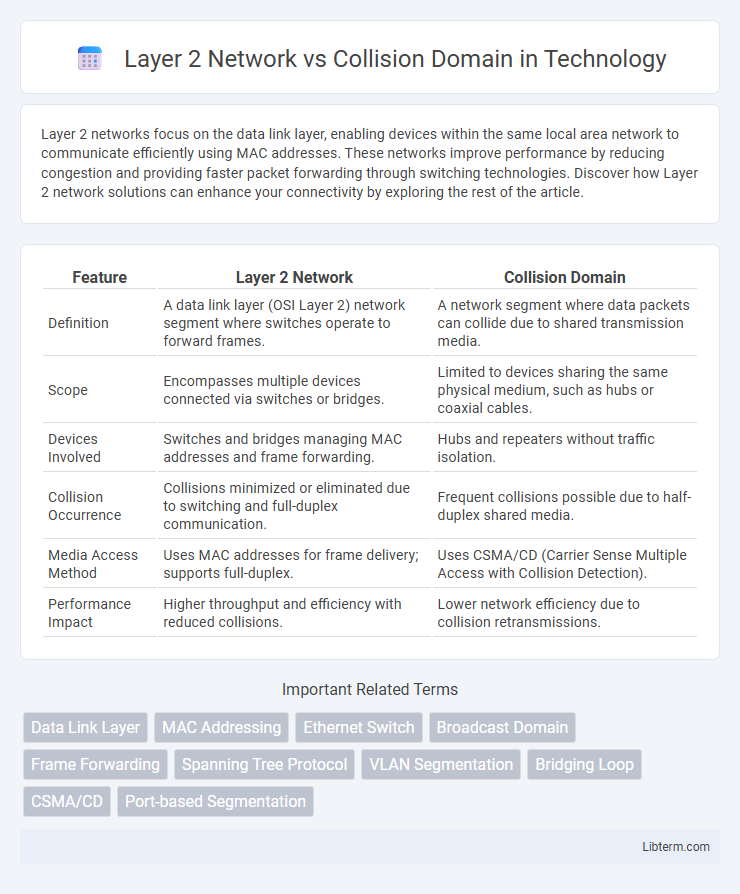Layer 2 networks focus on the data link layer, enabling devices within the same local area network to communicate efficiently using MAC addresses. These networks improve performance by reducing congestion and providing faster packet forwarding through switching technologies. Discover how Layer 2 network solutions can enhance your connectivity by exploring the rest of the article.
Table of Comparison
| Feature | Layer 2 Network | Collision Domain |
|---|---|---|
| Definition | A data link layer (OSI Layer 2) network segment where switches operate to forward frames. | A network segment where data packets can collide due to shared transmission media. |
| Scope | Encompasses multiple devices connected via switches or bridges. | Limited to devices sharing the same physical medium, such as hubs or coaxial cables. |
| Devices Involved | Switches and bridges managing MAC addresses and frame forwarding. | Hubs and repeaters without traffic isolation. |
| Collision Occurrence | Collisions minimized or eliminated due to switching and full-duplex communication. | Frequent collisions possible due to half-duplex shared media. |
| Media Access Method | Uses MAC addresses for frame delivery; supports full-duplex. | Uses CSMA/CD (Carrier Sense Multiple Access with Collision Detection). |
| Performance Impact | Higher throughput and efficiency with reduced collisions. | Lower network efficiency due to collision retransmissions. |
Introduction to Layer 2 Networks
Layer 2 networks operate at the data link layer, managing node-to-node data transfer and MAC addressing to ensure efficient communication within a local area network (LAN). They segment collision domains by using network devices such as switches, which reduce collisions by providing dedicated pathways for each connected device, unlike hubs that extend collision domains. Understanding the role of switches in Layer 2 networks highlights their importance in minimizing collisions and improving overall network performance.
Understanding Collision Domains
A collision domain refers to a network segment where data packets can collide when sent simultaneously, primarily occurring in Layer 2 networks such as Ethernet using hubs. Switches, operating at Layer 2, create separate collision domains for each connected device port, effectively reducing collisions and improving network performance. Understanding collision domains is essential for designing efficient Layer 2 networks, minimizing data packet collisions through segmentation and proper use of switches.
Key Differences Between Layer 2 Networks and Collision Domains
Layer 2 networks operate at the data link layer, managing MAC addresses and providing switching to connect devices within the same LAN, enabling multiple simultaneous communication paths. Collision domains are sections of a network where packet collisions can occur, typically limited to a single Ethernet segment using hubs or older devices. Key differences include that Layer 2 switches segment collision domains by creating separate domains per port, reducing collisions, while collision domains represent potential collision points within a shared medium.
Components of Layer 2 Networking
Layer 2 networking primarily involves devices such as switches and bridges that operate within a single collision domain to efficiently manage data traffic at the MAC address level. Switches segment a network into multiple collision domains, reducing collisions by directing frames only to the intended destination port, whereas hubs extend a single collision domain, increasing the chance of collisions. Key components like MAC address tables, VLANs, and Spanning Tree Protocol (STP) help control traffic flow and prevent loops within Layer 2 networks.
How Collision Domains Affect Network Performance
Collision domains in Layer 2 networks refer to segments where data packets can collide when multiple devices transmit simultaneously, causing network inefficiencies. In Ethernet environments, reducing the size of collision domains by using switches instead of hubs significantly minimizes collisions, leading to improved throughput and lower latency. Effective management of collision domains enhances overall network performance by decreasing retransmissions and optimizing bandwidth utilization.
Layer 2 Devices: Switches vs. Hubs
Layer 2 devices like switches operate by forwarding frames based on MAC addresses, effectively creating separate collision domains for each connected device, which minimizes collisions and improves network efficiency. In contrast, hubs broadcast data to all ports within a single collision domain, leading to frequent collisions and decreased performance. Switches provide full-duplex communication and support VLAN segmentation, while hubs function as simple repeaters without intelligence or traffic management capabilities.
Reducing Collision Domains in Modern Networks
Layer 2 networks utilize switches to segment collision domains, significantly reducing collisions compared to traditional hubs that extend a single collision domain. By creating separate collision domains for each switch port, modern Layer 2 switches isolate traffic, improving network efficiency and performance. This segmentation is critical in high-speed Ethernet networks where minimizing collision domains prevents packet loss and optimizes bandwidth utilization.
Impact of Layer 2 Segmentation on Collision Domains
Layer 2 segmentation significantly reduces the size of collision domains by dividing a network into smaller, isolated segments using devices like switches and bridges. Each switch port typically represents a separate collision domain, minimizing packet collisions and enhancing network performance. By limiting collision domains, Layer 2 segmentation improves bandwidth utilization and reduces latency in Ethernet networks.
Practical Examples: Layer 2 Network Design and Collision Isolation
A Layer 2 network segments devices using switches that create multiple collision domains, each port acting as a separate domain to reduce collisions and improve performance. In practical network design, placing workstations on individual switch ports isolates collisions to single links, avoiding network-wide broadcast disruption seen in hubs. For example, a network with a switch connecting multiple PCs prevents collision domains from overlapping, enhancing throughput and minimizing packet loss in office environments.
Best Practices for Managing Layer 2 Networks and Collision Domains
Efficient management of Layer 2 networks requires segmenting collision domains using switches instead of hubs to minimize collisions and improve bandwidth utilization. Implementing VLANs optimizes network performance by logically separating broadcast domains, reducing unnecessary traffic within collision domains. Regular monitoring with network analyzers and maintaining updated MAC address tables ensure prompt detection and resolution of Layer 2 issues, enhancing overall network reliability.
Layer 2 Network Infographic

 libterm.com
libterm.com